
Welcome to the Vienna Symphonic Library's series of Synchron Instruments! The instruments were recorded at Stage A, the main hall of Vienna's revitalized Vienna Synchron Stage. The recordings were executed using an expansive, phase-controlled multi-microphone set-up, capturing the articulations played in a scoring stage with exceptional acoustics, now ready to be used in your studio. This document will provide you with the information you need to use the Library with our Vienna Synchron Player.
You will also find references to Special Brass instruments closely connected to ones in the regular Brass collection: Trumpet 1 Sordino and Trumpets-4 Sordino.

All the instruments were recorded using up to 9 separate phase-coherent microphone configurations. The Standard Library includes 4 of these sections (as well as a RAM-friendly Room Mix section composed of merged samples from the individual positions), allowing you to integrate instruments recorded with a stereo Decca tree into your projects using the Vienna Synchron Player stand-alone or as a plug-in instrument. Adding the Extended Library and thus getting the Full Library expands your possibilities to 5.1 surround and Auro 3D 9.1.
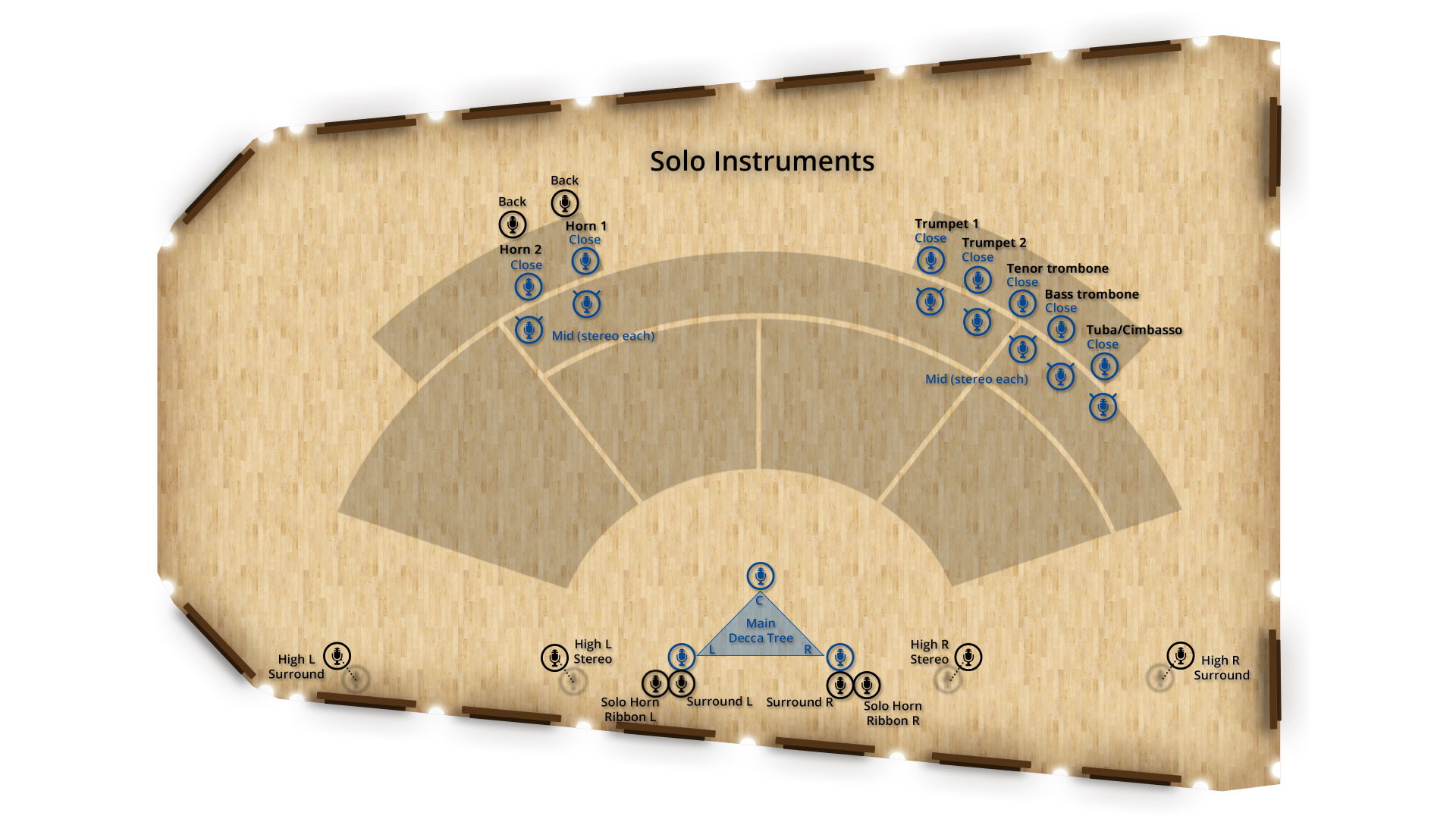

Standard Library
- Close Mic – Mono
- Mid Layer Mic – Stereo (L/R)
- Main/Room Mic – Decca Tree Stereo (L/R)
- Main/Room Mic – Decca Tree Mono (Center)
Extended Library
- Main Surround – Stereo (L/R)
- High Stereo (3D) – Stereo (L/R)
- High Surround (3D) – Stereo (L/R)
- Solo Horn Back Mic – Mono (Horn 1/2 only)
- Solo Horn Room Ribbon Mic – Stereo (L/R) (Horn 1/2 only)
The instrument presets also include different mixer presets. By default the Ambience room mixes are loaded, which feature the Standard Library microphone position "Room-Mix", for best performance out of the box.
All mixer presets are balanced in the stereo field to represent the respective instrument's position in the Synchron Stage set-up and are created by Bernd Mazagg, Technical Director & Chief Recording Engineer at Vienna Synchron Stage.
Room-Mix Presets
Come with the Standard Library and are based on a mix of all available room microphones, blended with Solo and Mid Mics.
Decca Tree Multi Mic Presets
Are also part of the Standard Library and are designed around the classic sound of the Decca Tree microphones.
Surround to Stereo Downmix Presets
Come with the Full Library and take advantage of the full array of microphones.
Surround Presets (only available in a surround setup)
Are also available with the Full Library and let you adjust the settings for any surround mixing situation, from 5.1 to immersive surround.
Processed Standard Library
Processed sounds with different characters.
You will also find more mixer presets (Close, Classic, Wide, Distant, Ambience, Wet, Lush, Lush Long, Sparkling, Catchy, Fanfare) in the first 3 categories.
Additionally, we have added "Signature" presets, created by Johannes Kirsch and Benjamin Belikov:
11. Signature Presets - Standard Library
Brave
A "lowpassed approach" to use the instruments in slow and silent passages.
Fierce
Harsh and direct sound to bring the focus to the corresponding instruments. Also can be used as one brass layer.
Petite
Designed to put the brass a little bit in the background to create space for other elements.
Eager
Wide and roomish sound to create big arrangements.
Victorious
Pristine sound in a big enviroment to widen up the arrangement.
12. Signature Presets - Full Library
Soaring
Designed to have an uplifting, soft, but still detailed sound while being upfront, making the featured instrument/section stand out. Great for solo lines, but avoid using it with too many instruments at once.
Nostalgic
Featuring a soft sound as well, but without sticking out as much as "Soaring" does.
Cathedral
Same as Nostalgic, but with added delay, giving it a huge room impression.
Amber
Compressed, slightly muffled and saturated sound.
Features similar characteristics as the Elite Strings’ "Amber" preset.
Glacier
An impressive view: The majestic white of the mountains gives you the chills. Soft attacks, espressivo and different vibrato variations will complement this breathtaking view.
Features similar characteristics as the Elite Strings’ "Glacier" preset.
Golden Times
Why just hear about the good old days if you can enjoy them yourself?!? The Hollywood of the 1940s and 1950s is always around the corner.
Features similar characteristics as the Elite Strings’ "Golden Times" preset.
Enraged
Compressed and EQed to create an angry, dry brass sound. Combine this with "Con fortissimo" articulations and compression on the brass mix bus for maximum effect.
Auro 3D is an immersive audio technology that allows for three-dimensional sound perception. The Belgian company Auro Technologies developed this technology based on a special speaker configuration, adding four additional speakers to a 5.1 surround configuration. These speakers (so-called "heights") are situated above the front and surround speakers and generate acoustic reflections that are perceived naturally due to the fact that sounds originate from around as well as from above the listener. Thanks to the comprehensive selection of discrete audio channels with the Full Library, you may mix your instruments in Auro 3D as well as in Dolby Atmos.
The collection’s instruments provide two different kinds of Presets, accessible by clicking on the icons “Flow” resp. “Precision” in the Synchron Player’s top bar. Flow Presets offer an intuitive, graphic approach to the library’s contents, with instrument, articulation, and sound parameters displayed in a single window.
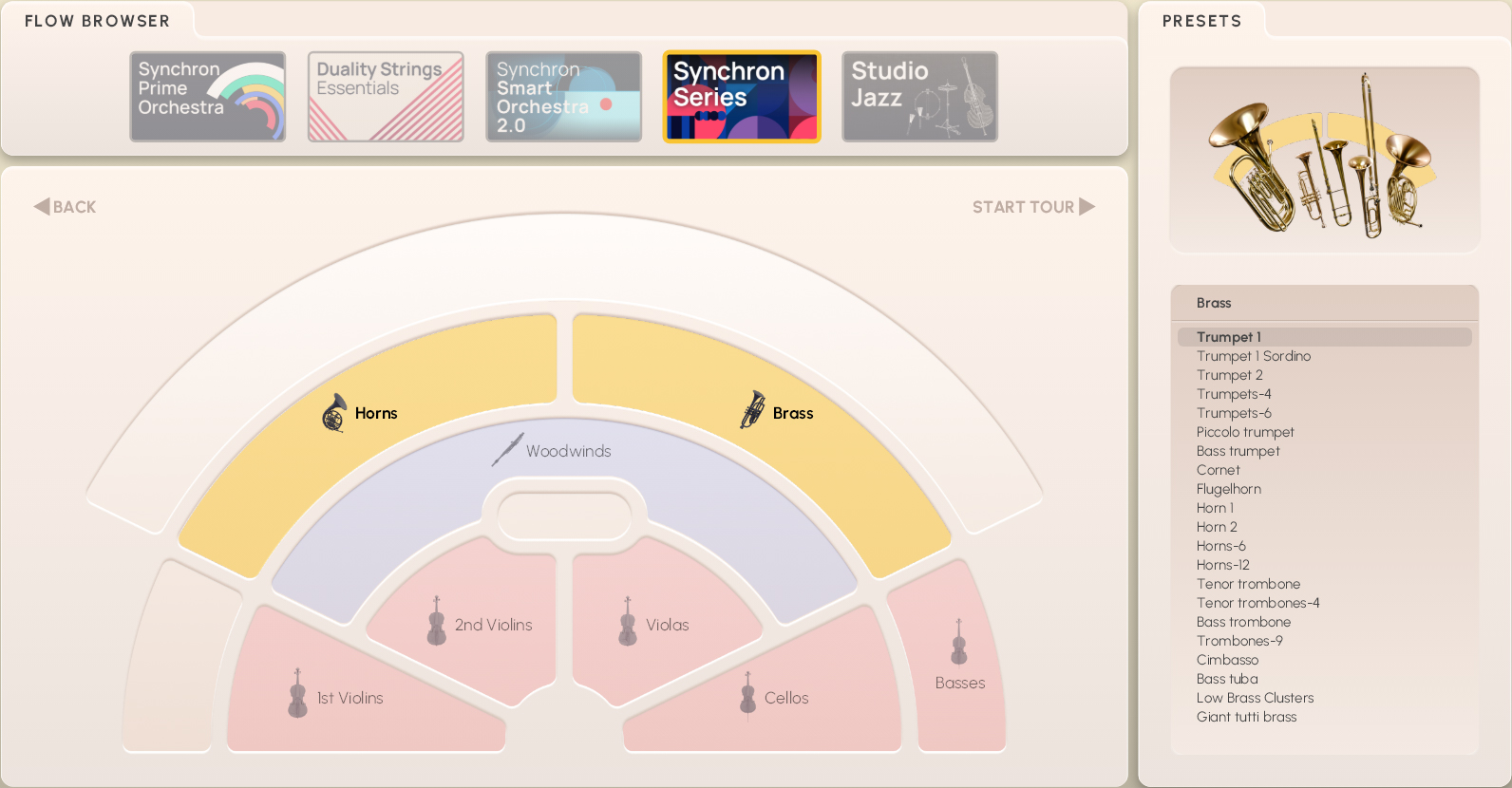
Precision Presets are what you already know if you own other VSL libraries. They allow you to explore the depths of the library, adjusting and tweaking parameters as you see fit.
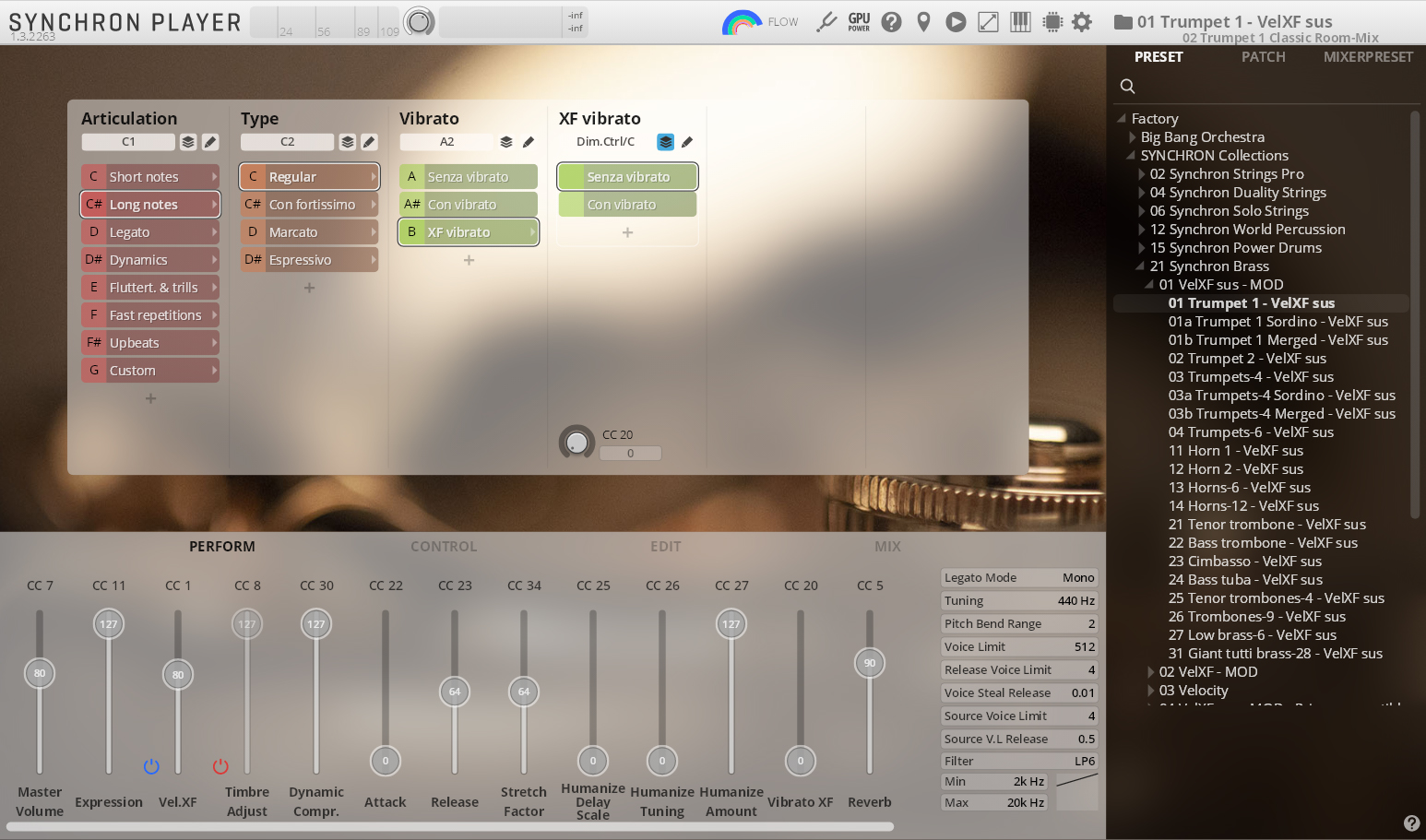
For each instrument, there are a number of Mixer Presets for stereo and surround microphone configurations that depict different recording situations: Close, Classic, Wide, Distant, and Ambience. The stereo options also offer Lush, Lush long, Sparkling, Catchy, and Fanfare. Apart from that, you will also find Processed Standard Mixer Presets, which give you an idea of the possibilities and may present a good starting point for your own creations, as well as Signature Presets tailored to the respective instrument.
Flow Presets give you instant access to the most important parameters of an instrument, its articulations, and general sound settings in the Synchron Player’s Flow view. The display is subdivided accordingly, with the graphic keyboard underneath. On the Flow Browser page, you can click on START TOUR to step through explanations of the different Flow elements and parameters as shown below.
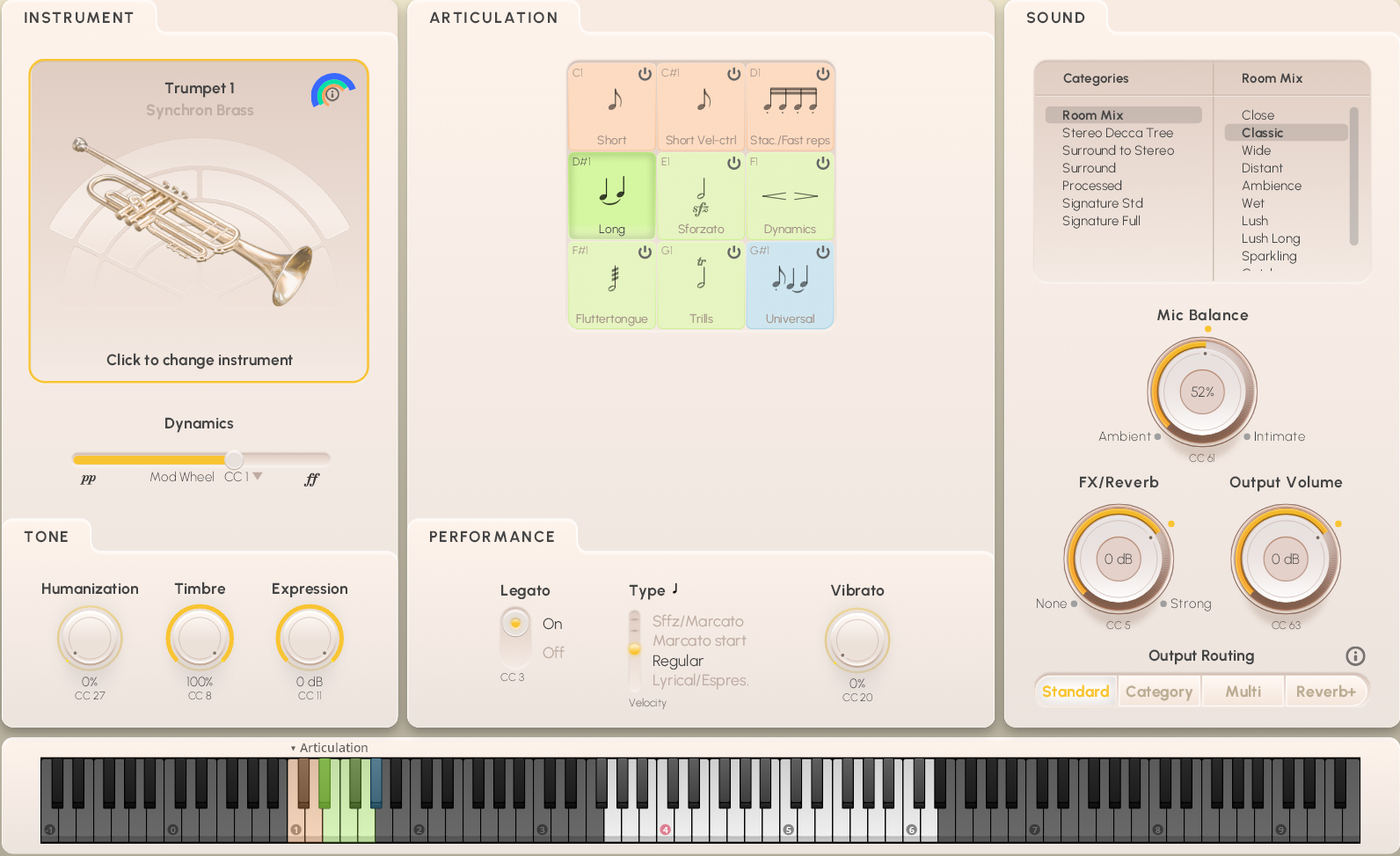
The Instrument section shows a symbolic image of the selected Instrument, headed by the name of the loaded Preset. You can return to the Flow Browser to select another instrument by clicking on the field. Clicking on the Info circle will connect you to the Vienna Academy, our instrumentology site.
The Dynamics fader under the instrument is set to the modwheel (MIDI CC1) or keystroke velocity by default – with the long notes used in the example below, it is the modwheel, meaning that you can influence the volume of a note being played by changing the controller value. You could also set it to a breath controller (MIDI CC2), leaving your hand free for other stuff. The staccatos, e.g., are set to keystroke velocity, as changing the volume of short notes while they are sounding hardly makes sense.
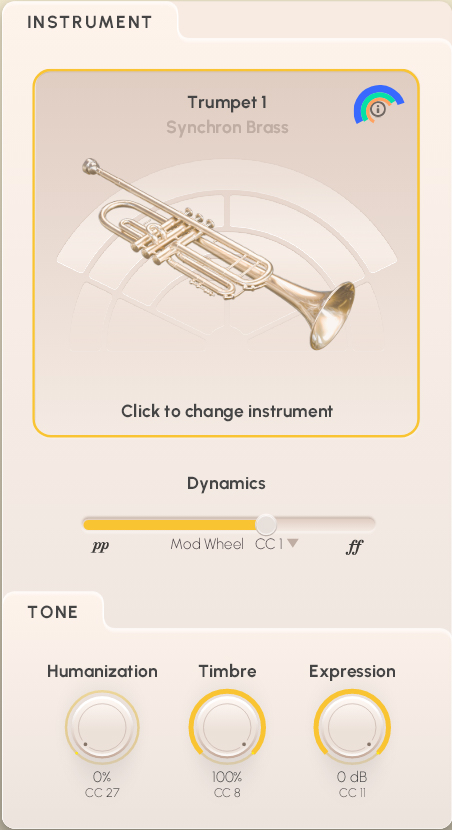
In the Tone field, you get access to three other items which may be an important factor in making your piece sound truly alive:
Humanization (MIDI CC27) lets you determine the percentage of not being exactly on time – a kind of counter-quantization that introduces an element of necessary imperfection.
Timbre (MIDI CC8) affects the tone of the instrument, making it sound brighter or darker.
Expression (MIDI CC11) is an additional volume control defining a percentage of CC7 (volume), and can be used for automation.
The Articulation pane holds all the samples, so to speak. In the upper field, you see the possible choices with their keyswitches, which are also marked on the Synchron Player’s virtual keyboard. Of course, you can also click on a button to switch to that articulaton. The articulation buttons are color-coded: orange for short notes, green for long ones, and blue for the Universal articulation that allows you to perform without keyswitching.
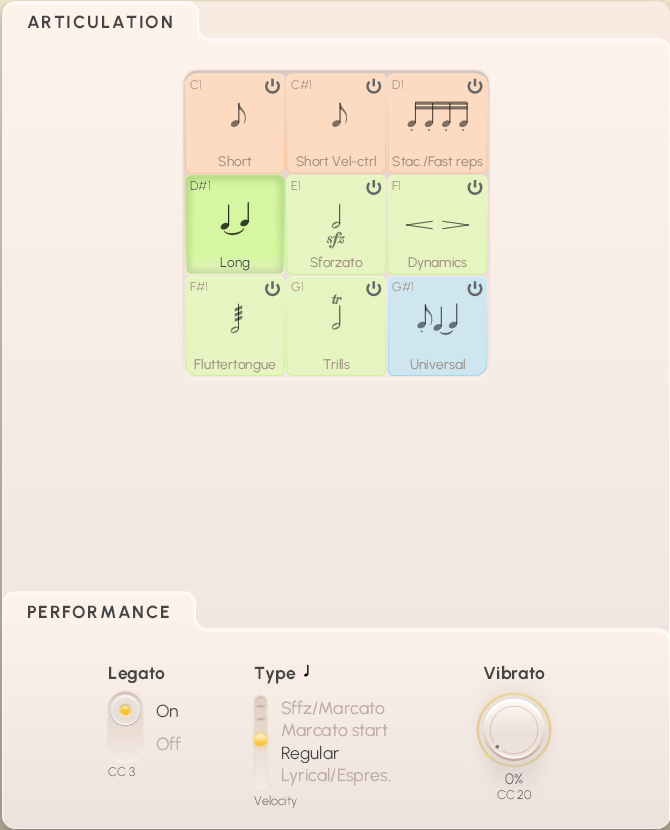
The Performance field contains all the playing variants of the selected articulation. So, depending on the number and type of variants, the performance options may look quite simple. There are up to four different parameters per articulation. Here’s a few examples:
Short notes allow you to choose Switch-Type (MIDI CC101), i.e., you can select the type of short note played either with keyswitches or with the modwheel.
Type control for other articulations is mostly set to keystroke velocity, or to keyswitches as with the bass flute’s effects.
The Legato option of long notes and trills can be switched on and off with MIDI CC3.
Some instruments feature a Vibrato fader knob assigned to MIDI CC20, allowing you to “soft-switch” with a narrow crossfade area between samples without and with vibrato.
Release offers different release options – e.g., switching between ringing and cut release of the fast repetitions – with the help of MIDI CC4.
In the Sound pane, you can select a basic Category on the top left, and one of the Mixer Presets from that category on the right.
Mic Balance (MIDI CC61) adjusts the relation between intimate and ambient microphoning.
FX/Reverb (MIDI CC5) sets the amount of reverb, which is different in intensity according to the selected preset.
Output Volume (MIDI CC63) takes care of how much of what you do comes out of the Synchron Player.

Finally, there is the choice of Output Routing represented by the four buttons Standard, Category, Multi, and Reverb+:
Standard is the standard Stereo configuration where all microphones are routed to the master output.
Category: here, only the ambient microphones are routed to the master output, while close microphones go to ouput 2,
Multi routes all microphones to different outputs.
Master out – Main, Room-Mix, Reverb
Output 2 – Main-Center
Output 3 – Surround
Output 4 – High-Surround
Output 5 – Mid
Output 6 – CloseReverb+ is routed like the Multi configuration, but has the Reverb channel routed to its own output 11.
If you’re not sure about the routing options, you can also click on the information button next to the heading.

Precision Presets comprise all recorded Patches of an instrument or ensemble in Articulation groups, which again contain Types of the respective Articulation, with further options if available. If you happen to be short of RAM, you can deactivate Articulations you do not need, and if necessary activate them again.
By default the Articulation keyswitches are mapped starting from C1 (for Middle C = C4) for trumpets, horns, tenor trombone, the trombone ensemble of 4 players, and starting from C6 for the other instruments – bass trombone, cimbasso, bass tuba, the 9-player trombone ensemble, and the tutti ensemble. The "Low brass" Preset has its line-ups mapped from C1 to D#1 and its articulations starting from C5.
The Type keyswitches start from C2 for the trumpets, C7 for the tutti, and C6 for all other Presets. The mapping of keyswitches for further options such as release variants depend on the instrument, and will be listed there.
Dimension Controllers offer additional options within some Articulations or Types, most notably that of adding marcato attacks to long notes, or crossfading between vibrato variants. The controller function is indicated by the respective caption, as of course it may take on different tasks as needed.

There are three basic Preset types for every section, marked "VelXF sus", "VelXF", and "Velocity". In the first, velocity crossfading is activated for long notes and can be controlled with MIDI controller CC1, the modwheel, while the dynamics of short notes are controlled by keystroke velocity, thus facilitating phrasing. In the second, all articulations have velocity crossfading activated for MIDI CC1, while the third Preset reacts only to keystroke velocity. Velocity crossfading can be enabled or disabled by clicking its on/off symbol in the Synchron Player's Perform tab.
Apart from the individual solo instruments and ensembles, there is a "Low brass" Preset with 6 players (4 bass trombones, tuba, contrabass tuba) which also contains cluster articulations, and a "Tutti" Preset with 28 players (6 trumpets, 12 horns, 9 trombones, bass tuba).
The Synchron Player feature "Timbre Adjust" presents a great alternative and addition to Velocity XFade. It is an intelligent filter tuned to work with Synchron Brass, as it simulates dynamic changes without actually switching through the available velocity layers. It can be controlled with MIDI CC8.
The velocity split points of patches are:
2 Layers: 0–80, 81–127
3 Layers: 0–40, 41–100, 101–127
4 Layers: 0–40, 41–80, 81–100, 101–127
Short and long staccato, bold and agile; portato bold and agile; and portato long.
- Bold / Agile: A0/B0
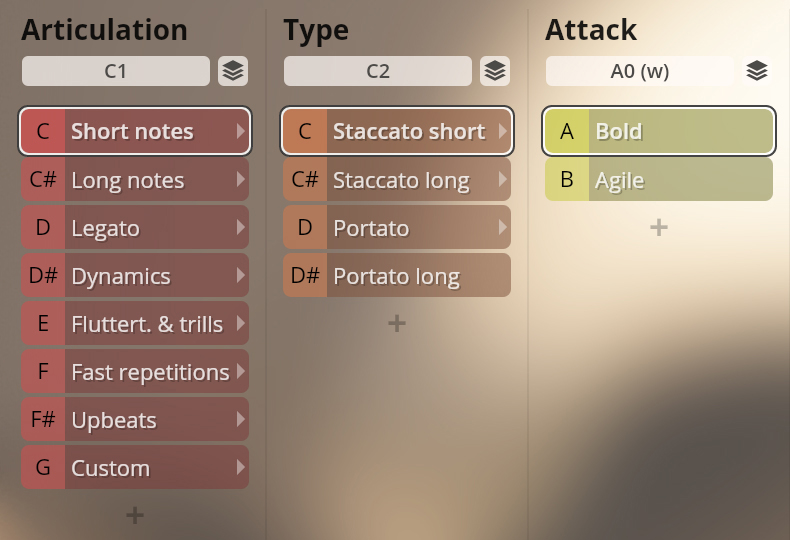
Sustained notes, regular, con fortissimo, and espressivo with and without vibrato, and a regular/marcato attack option.
- Vibrato options: A2–B2
- Vibrato crossfading: Dim.Ctrl/C (MIDI CC20)

- Marcato intensity: Dim.Ctrl/A
- VelXF sus and VelXF Preset: keystroke velocity; Velocity Preset: MIDI CC3
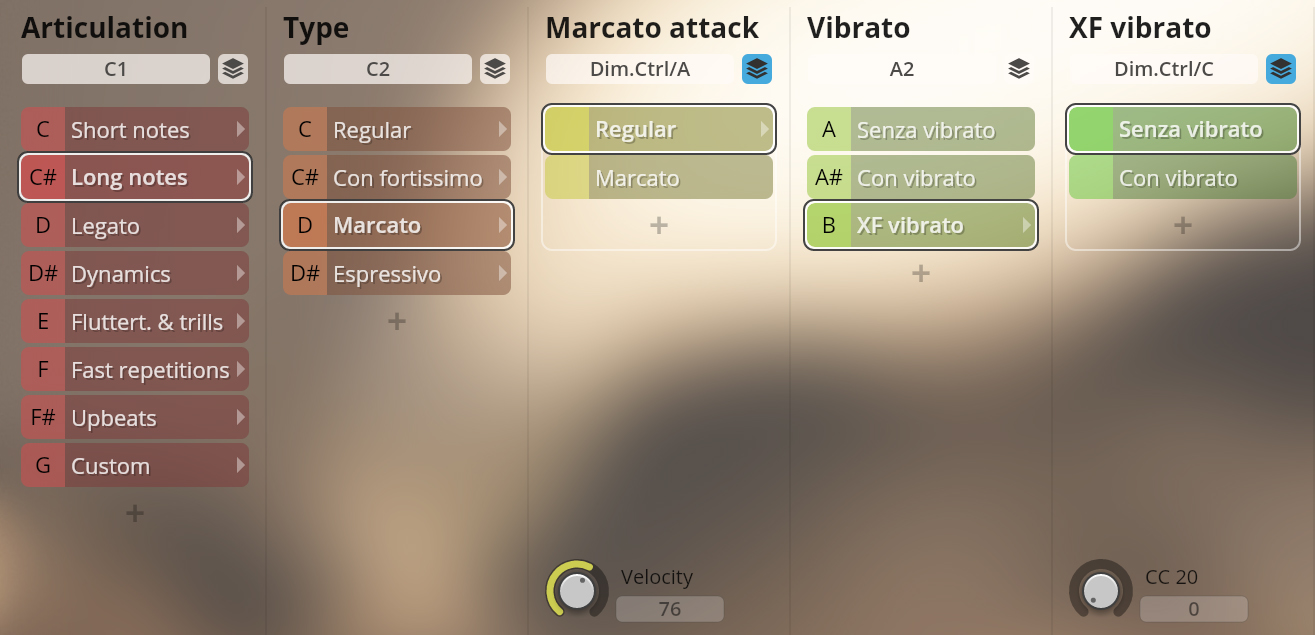
Legato regular and con fortissimo, normal and fast with and without vibrato, and espressivo with and without vibrato, and marcato start notes.
- Speed options: F2–G2
- Vibrato options: A2–B2
- Vibrato crossfading: Dim.Ctrl/C (MIDI CC20)
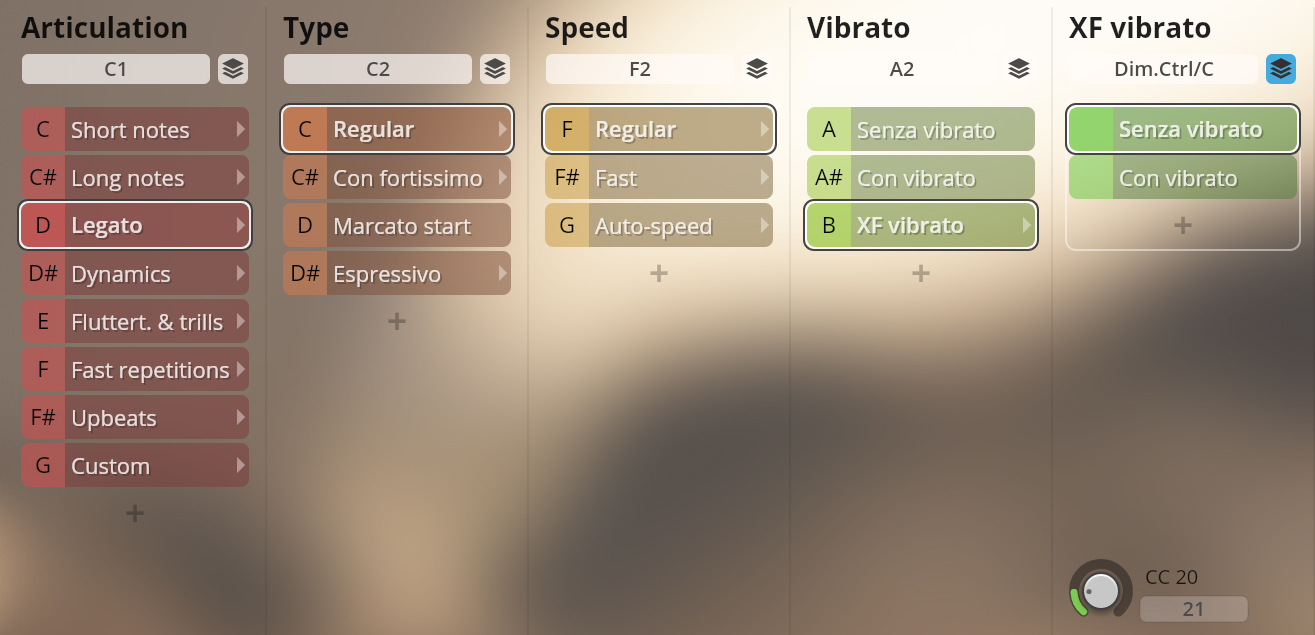
This option implements a controller on Dim.Ctrl/D to switch automatically between regular and fast legato according to playing speed.
- Speed controller: Dim.Ctrl/D (playing speed)
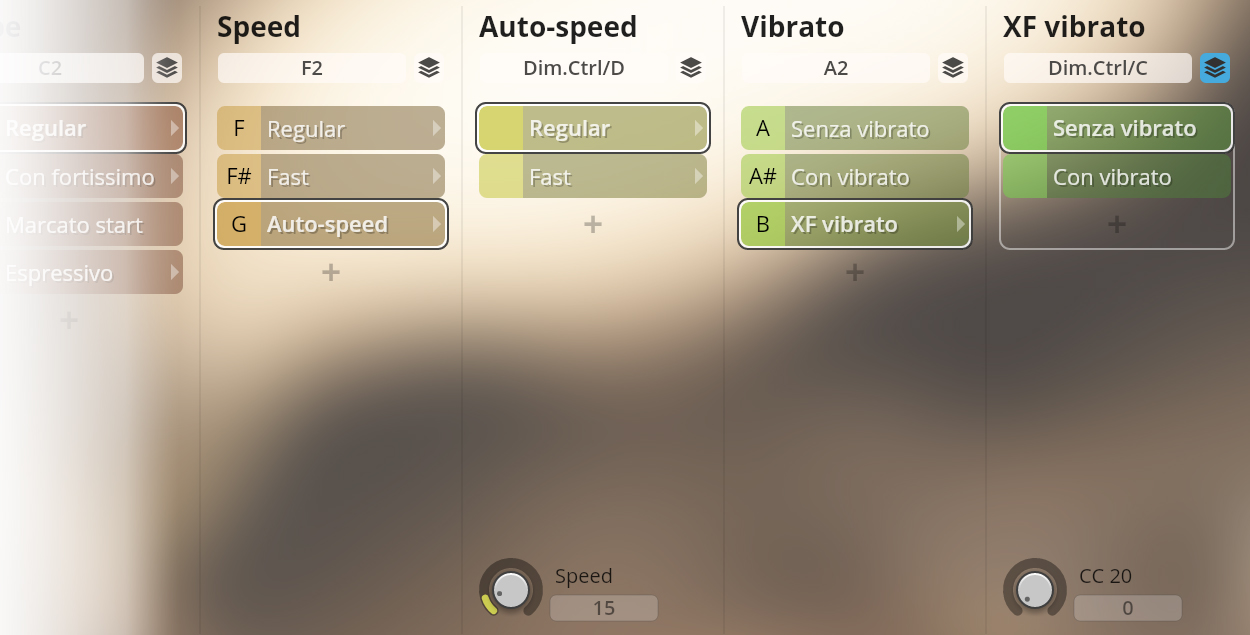
Unlike regular and con fortissimo, espressivo does not offer different playing speeds.
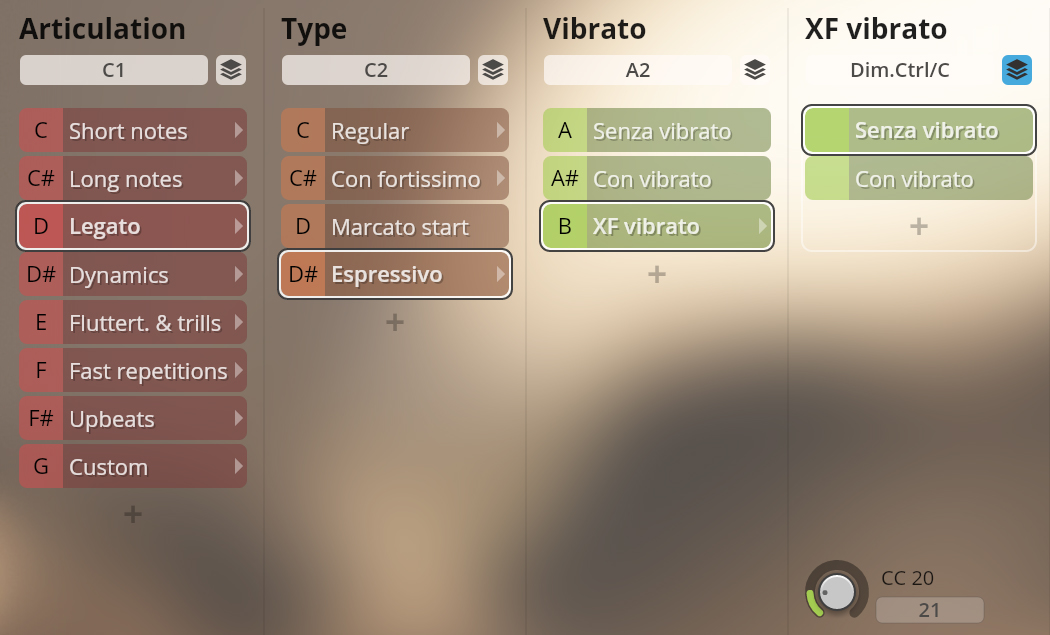
Sforzato and sforzatissimo; strong crescendo and diminuendo, 2/3/4 sec.; soft crescendo and diminuendo with and without vibrato, 2/3/4 sec.
- Crescendo/diminuendo duration: G2–A2.
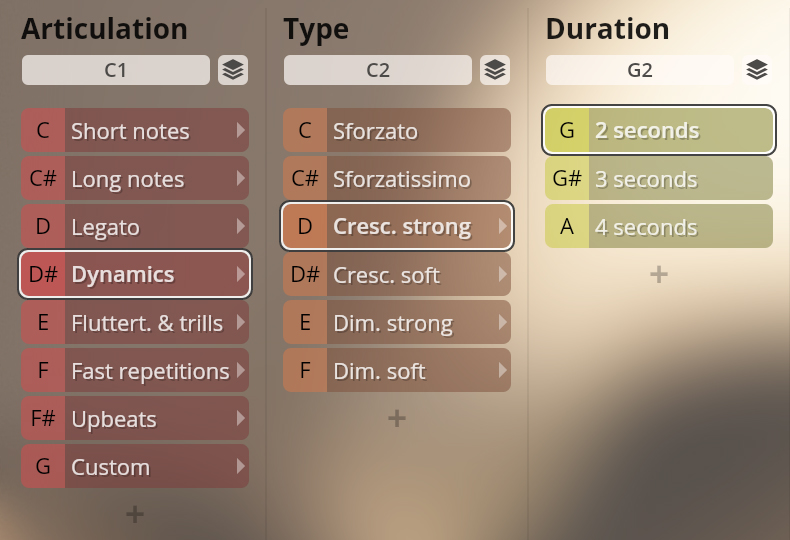
- Vibrato options: A2–B2
- Vibrato crossfading: Dim.Ctrl/C (MIDI CC20)

Flutter tonguing, normal and marcato; half and whole tone trills.
- Marcato intensity: Dim.Ctrl/A – VelXF sus and VelXF Preset: keystroke velocity; Velocity Preset: MIDI CC3
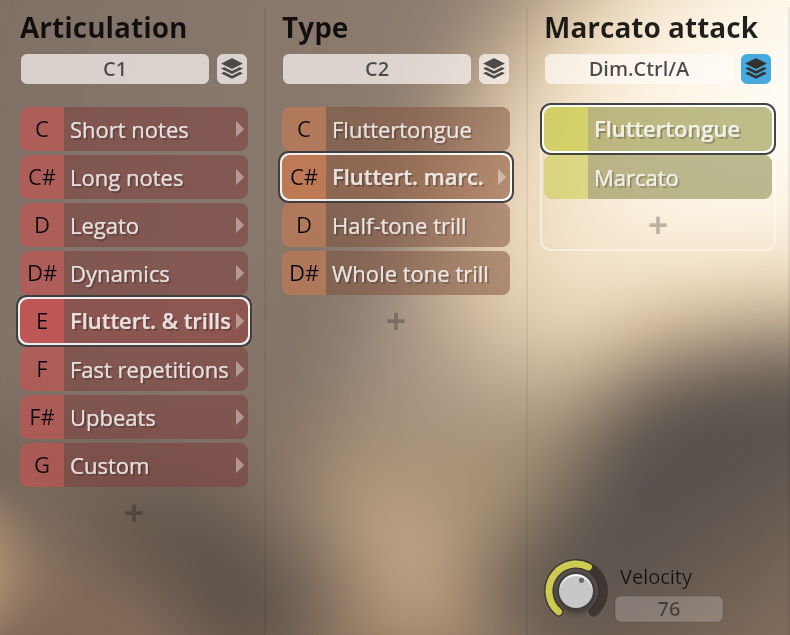
Fast repetitions, 120/130/140/160 bpm, with ringing and cut release.
- Ringing/cut release: A0/B0
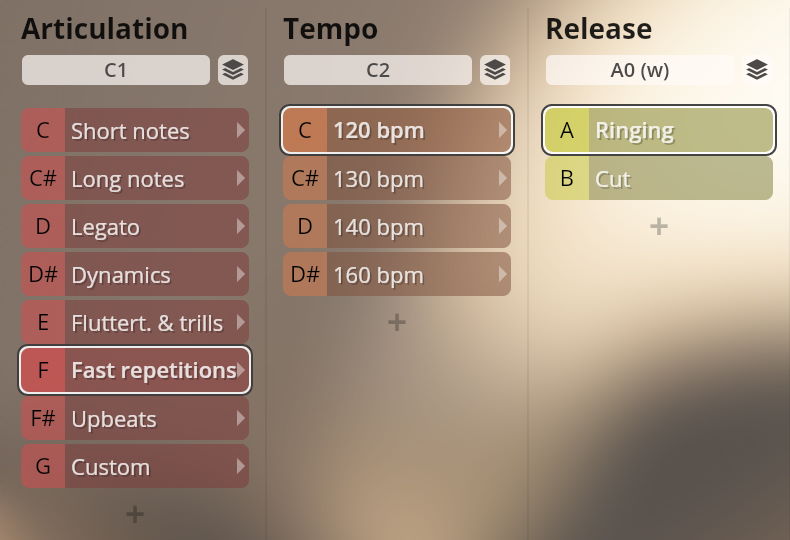
1–3 upbeats.
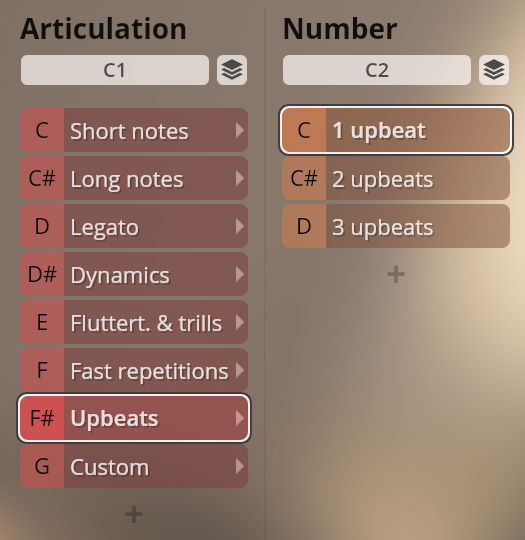
With some exceptions, Trumpet 1 Sordino (Special Brass) has the same articulations as Trumpet 1. Owners of both instruments are also provided with a merged Preset, where one can switch between articulations without and with sordino via keyswitch.
Senza/con sordino: A6/B6.
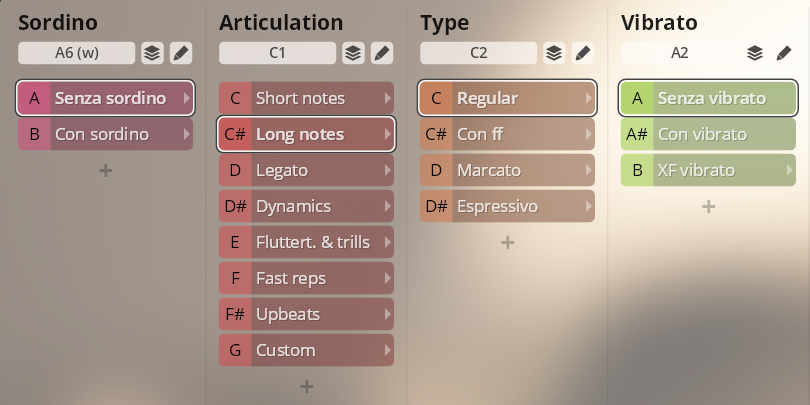
Staccato, bold and agile.
- Bold / Agile: A0/B0
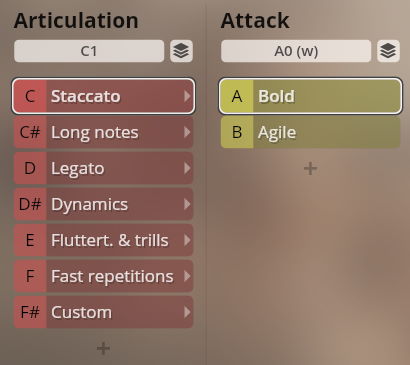
Sustained notes, regular and con fortissimo, and a regular/marcato attack option.
- 4 players only: Espressivo
- Marcato intensity: Dim.Ctrl/A – VelXF sus and VelXF Preset: keystroke velocity; Velocity Preset: MIDI CC3.
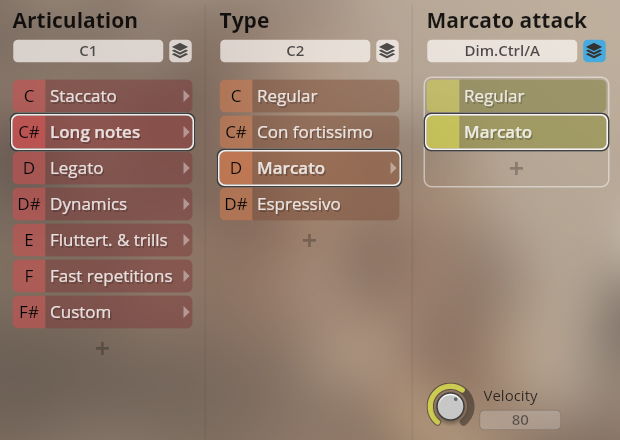
Legato regular and con fortissimo, and marcato start notes.
- 4 players only: espressivo.
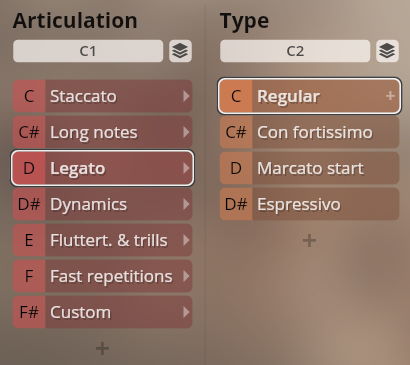
Sforzato and sforzatissimo; strong crescendo, 2/3.5 sec.
- 4 players only: soft and very soft crescendo, soft diminuendo
- Strong crescendo duration: F#2/G2
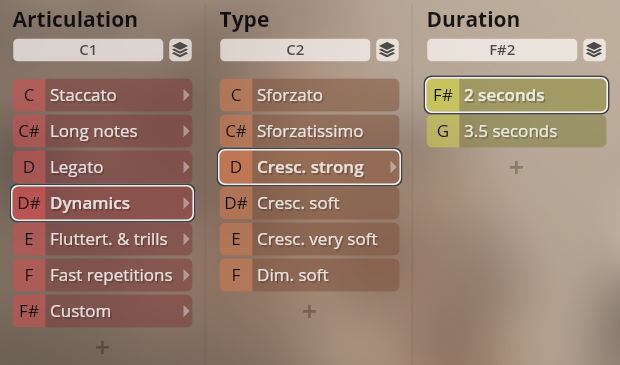
Flutter tonguing, normal and marcato; half and whole tone trills.
- Marcato intensity: Dim.Ctrl/A – VelXF sus and VelXF Preset: keystroke velocity; Velocity Preset: MIDI CC3.
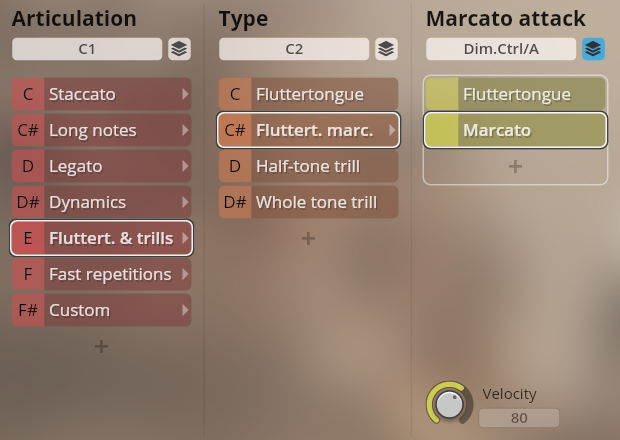
Fast repetitions, 120/130/140/160 bpm, with ringing and cut release.
- Ringing/cut release: A0/B0
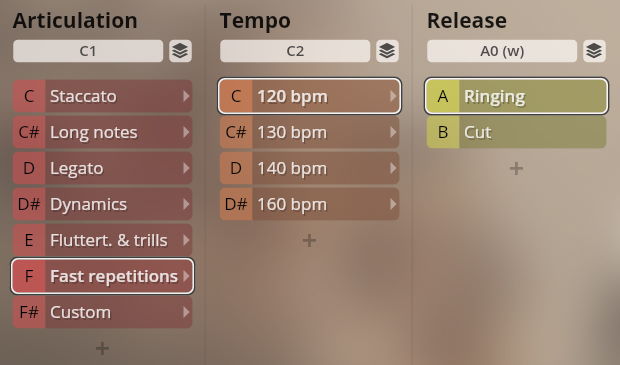
With some exceptions (e.g., no soft crescendos and diminuendos), Trumpets-4 Sordino (Special Brass) has the same articulations as the regular trumpet ensemble Trumpets-4. Owners of both instruments are also provided with a merged Preset, where one can switch between articulations without and with sordino via keyswitch.
Senza/con sordino: A6/B6.
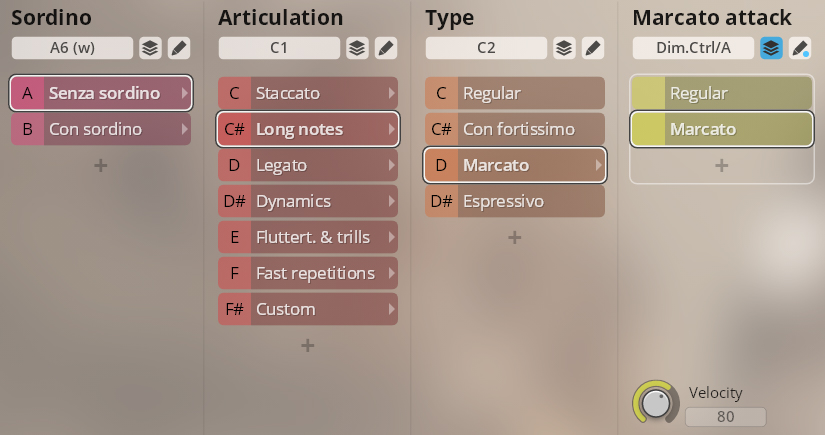
Short and long staccato, bold and agile; portato bold and agile; and portato long.
- Bold / Agile: A0/B0
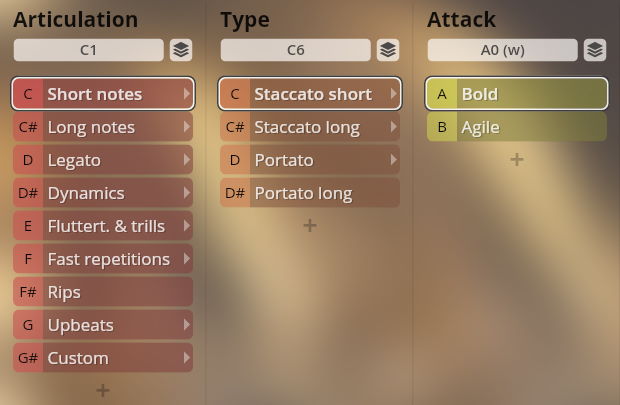
Sustained notes, regular, con fortissimo, and espressivo, and a regular/marcato attack option.
- Marcato intensity: Dim.Ctrl/A – VelXF sus and VelXF Preset: keystroke velocity; Velocity Preset: MIDI CC3
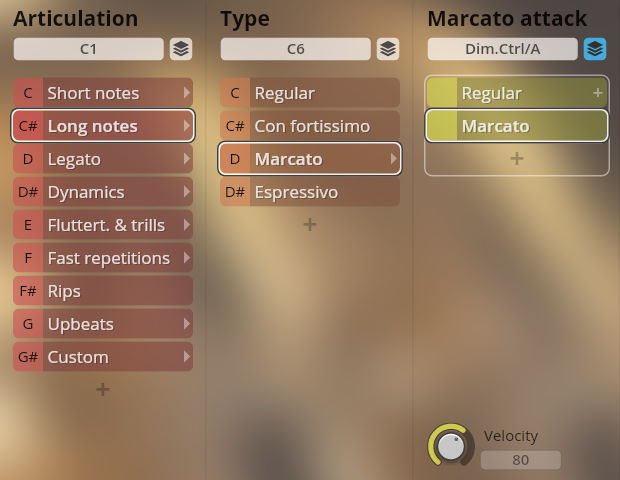
Legato regular and con fortissimo, normal and fast; espressivo; and marcato start notes. The auto-speed option implements a controller on Dim.Ctrl/D to switch automatically between regular and fast legato according to playing speed.
- Speed options: F6–G6
- Speed controller: Dim.Ctrl/D (playing speed)
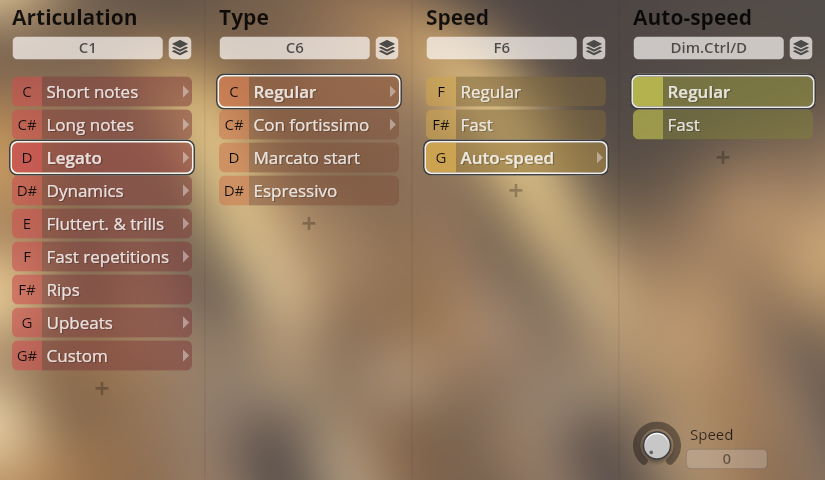
Sforzato and sforzatissimo; strong and soft crescendo and diminuendo, 2/3/4 sec.
- Crescendo/diminuendo duration: G2–A2
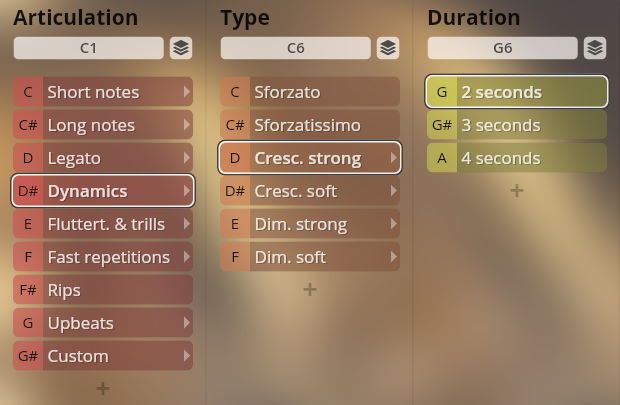
Flutter tonguing, normal and marcato; half and whole tone trills.
- Marcato intensity: Dim.Ctrl/A – VelXF sus and VelXF Preset: keystroke velocity; Velocity Preset: MIDI CC3
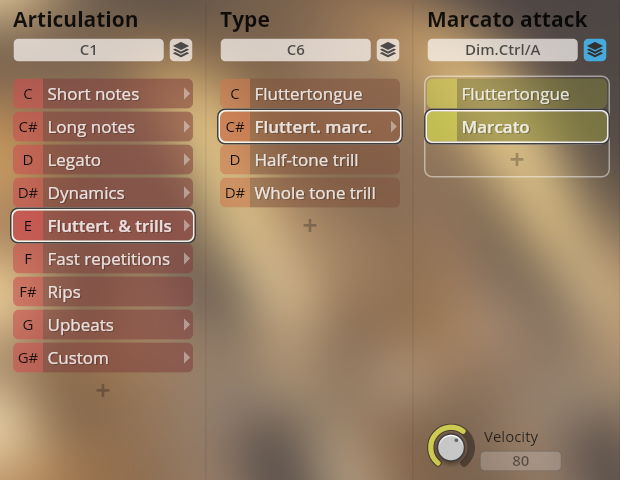
Fast repetitions, 120/130/140/160 bpm, with ringing and cut release.
- Ringing/cut release: A0/B0

No further options.
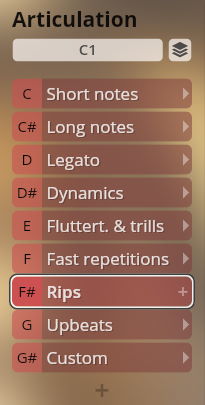
1–3 upbeats.
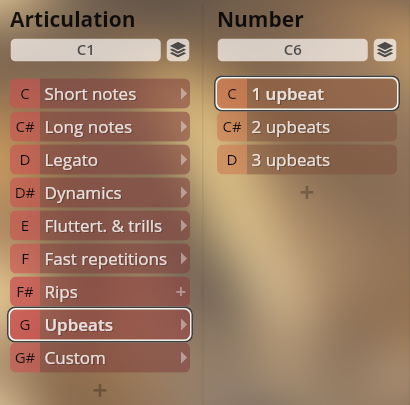
Staccato, bold and agile.
- Bold / Agile: A0/B0
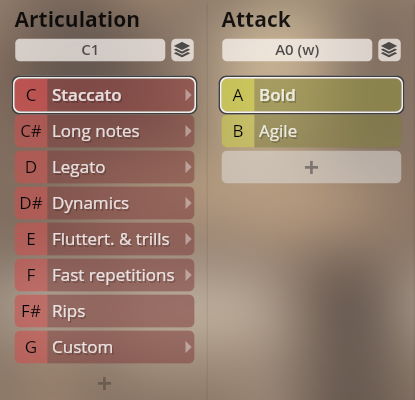
Sustained notes, regular, con fortissimo, espressivo, and a regular/marcato attack option.
- Marcato intensity: Dim.Ctrl/A – VelXF sus and VelXF Preset: keystroke velocity; Velocity Preset: MIDI CC3
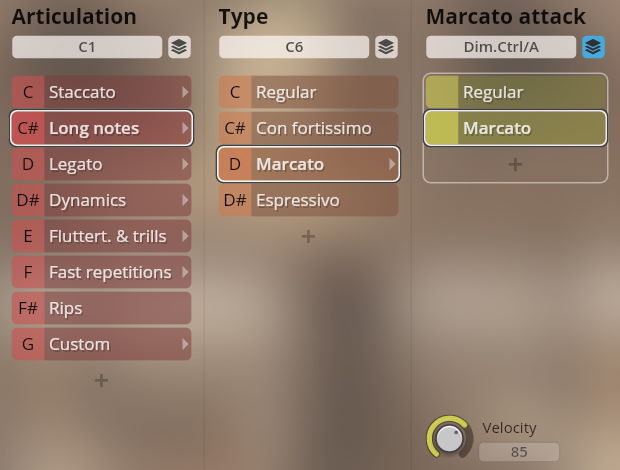
Legato regular, con fortissimo, espressivo, and marcato start notes.
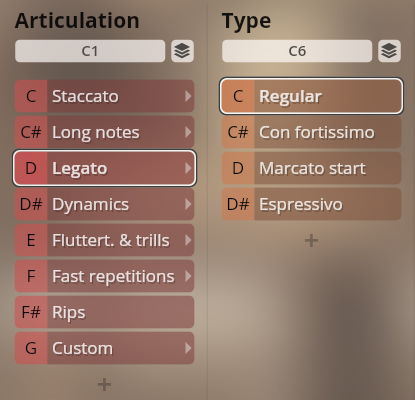
Sforzato and sforzatissimo; strong crescendo, 2/4 sec.
- 6 players only: soft and very soft crescendo, soft diminuendo
- Strong crescendo duration: G2–A2
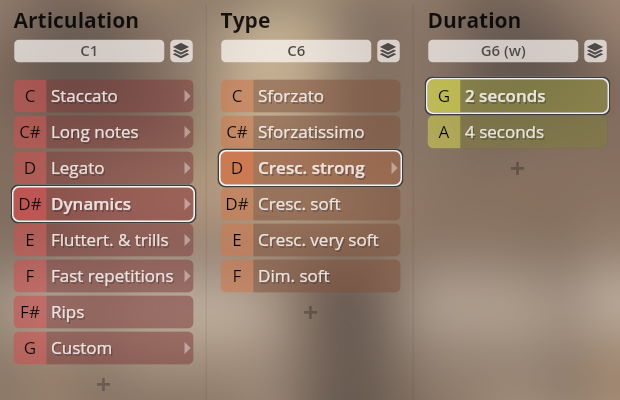
Flutter tonguing, normal and marcato; half and whole tone trills.
- Marcato intensity: Dim.Ctrl/A – VelXF sus and VelXF Preset: keystroke velocity; Velocity Preset: MIDI CC3
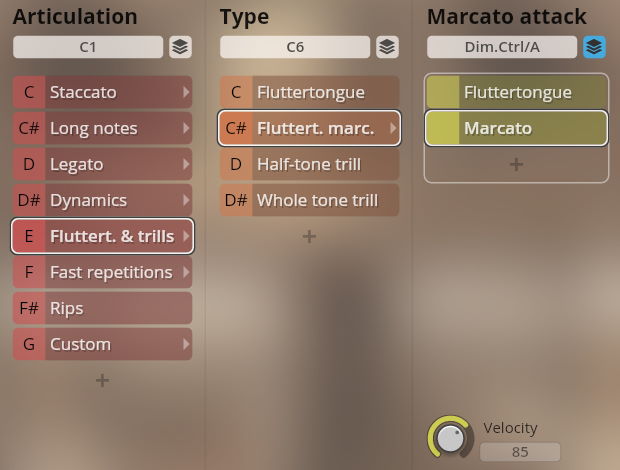
Fast repetitions, 120/130/140/160 bpm, with ringing and cut release.
- Ringing/cut release: A0/B0
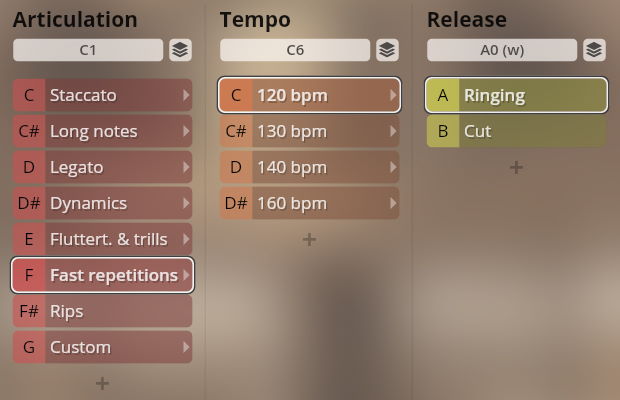
12 Horns: Rips, slow and fast.
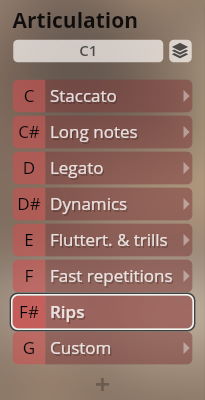
Staccato and portato, bold and agile; portato long.
- Bold / Agile: A0/B0

Sustained notes, regular, con fortissimo, and espressivo, and a con fortissimo/marcato attack option.
- Marcato intensity: Dim.Ctrl/A – VelXF sus and VelXF Preset: keystroke velocity; Velocity Preset: MIDI CC3
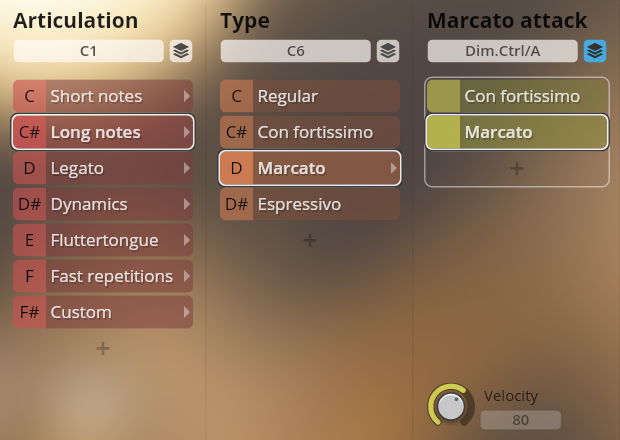
Legato regular and con fortissimo, normal and fast; espressivo; and marcato start notes. The auto-speed option implements a controller on Dim.Ctrl/D to switch automatically between regular and fast legato according to playing speed.
- Speed options: F6–G6
- Speed controller: Dim.Ctrl/D (playing speed)
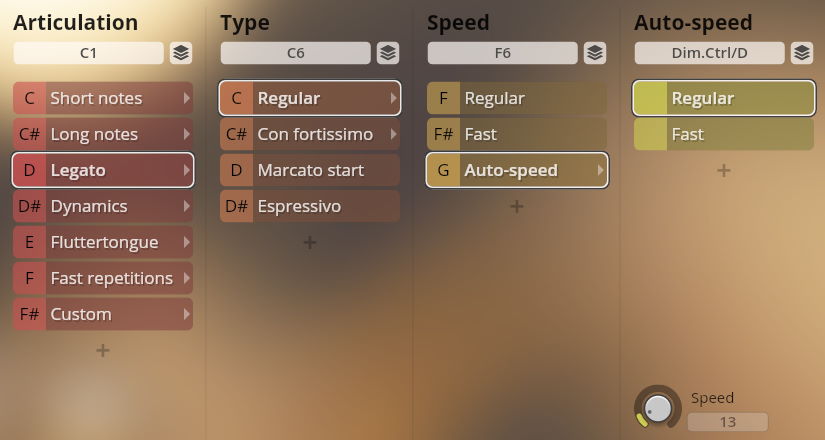
Only the tenor trombone has strong and soft crescendo variations.
- Crescendo/diminuendo duration: G6–A6

Half and whole tone trills.
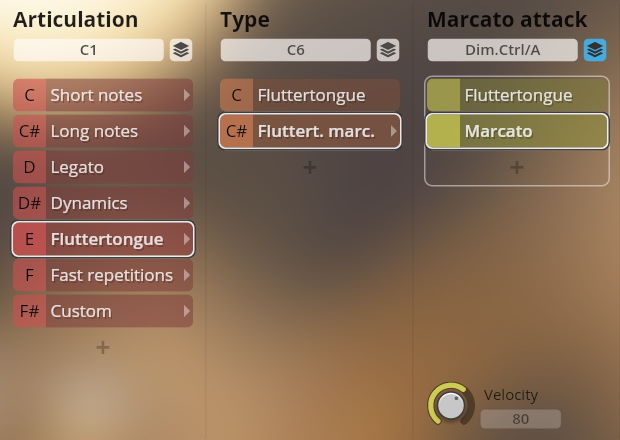
Flutter tonguing, normal and marcato.
- Marcato intensity: Dim.Ctrl/A – VelXF sus and VelXF Preset: keystroke velocity; Velocity Preset: MIDI CC3

Fast repetitions, 120/130/140/160 bpm, with ringing and cut release.
- Ringing/cut release: A0/B0
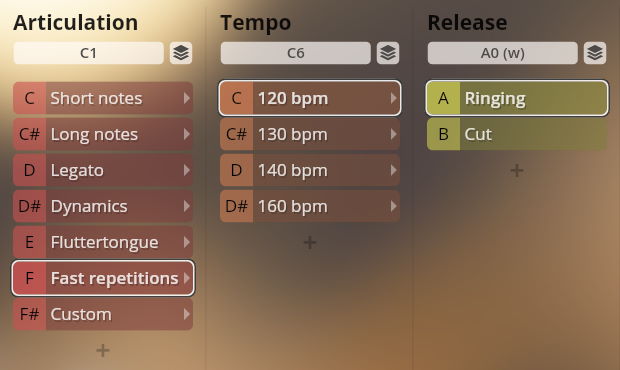
Staccato, bold and agile.
- Bold / Agile: A0/B0
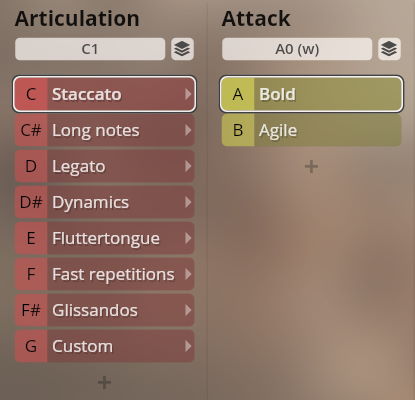
Sustained notes, regular, con fortissimo, espressivo, and a regular/marcato attack option.
- Marcato intensity: Dim.Ctrl/A – VelXF sus and VelXF Preset: keystroke velocity; Velocity Preset: MIDI CC3
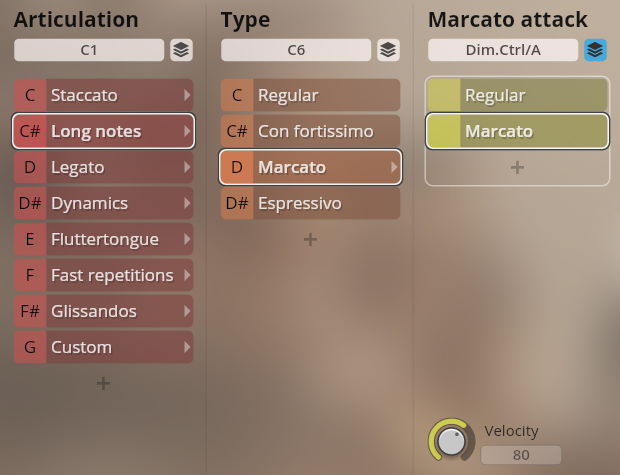
Legato regular, con fortissimo, espressivo, and marcato start notes.

Sforzato and sforzatissimo; strong crescendo, 2/4 sec.; soft and very soft crescendo, soft diminuendo.
- Strong crescendo duration: G2–A2
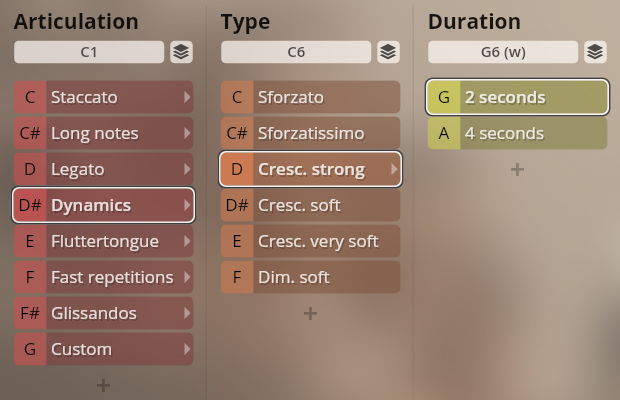
Flutter tonguing, normal and marcato.
- Marcato intensity: Dim.Ctrl/A – VelXF sus and VelXF Preset: keystroke velocity; Velocity Preset: MIDI CC3

Fast repetitions, 120/130/140/160 bpm, with ringing and cut release.
- Ringing/cut release: A0/B0
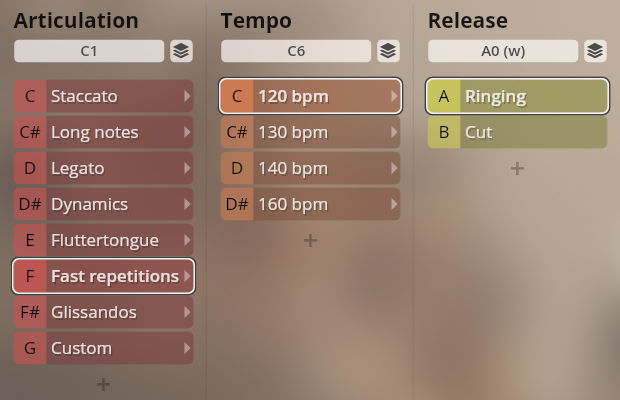
Glissandos, up and down, minor and major 2nds, and 4ths.
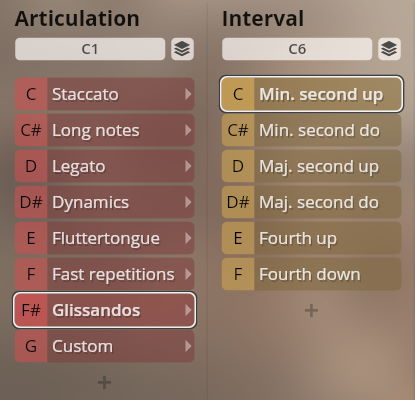
Staccato, bold and agile.
- Bold / Agile: A4/B4

Sustained notes, regular, con fortissimo, soft with normal and fast attack, and a regular/marcato attack option.
- Normal/fast attack: A4/B4
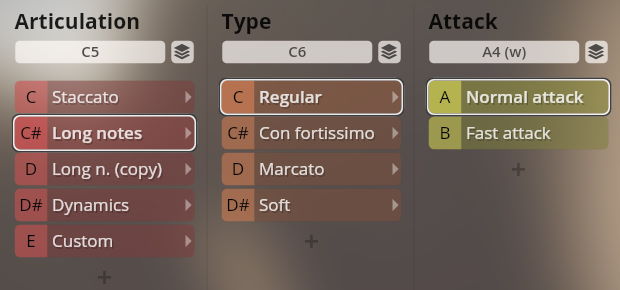
- Marcato intensity: Dim.Ctrl/A – VelXF sus and VelXF Preset: keystroke velocity; Velocity Preset: MIDI CC3.
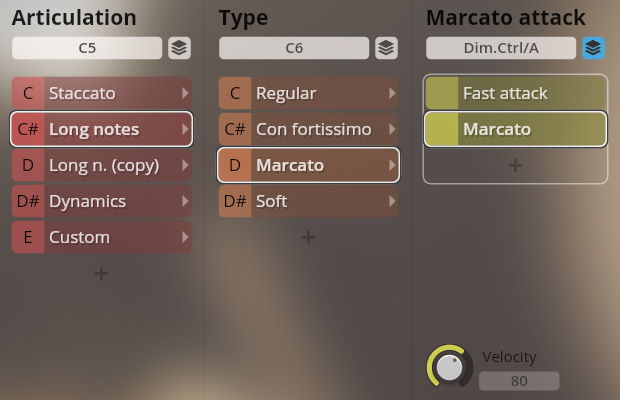
Sforzato and sforzatissimo; crescendo, 2/4 sec.
- Crescendo duration: G2–A2
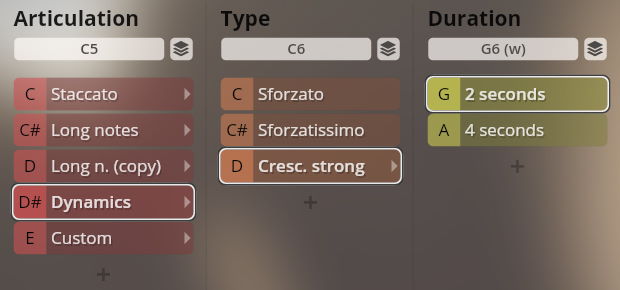
The Low brass Presets feature different line-ups, two of them with cluster articulations. The line-up with 5 players and contrabass tuba only offers Staccato, Long notes, and Dynamics articulations, and the 6 player clusters lack Legato. These two have a copy of the Long notes instead of Legato.
- Line-up: C1–D1
- Articulations: C5–G5
Staccato, bold and agile.
- Bold / Agile: A0/B0

The articulations of this line-up are the same as those of that with 5 players, but offer the possibility to crossfade between regular notes and clusters.
- Cluster XF: Dim.Ctrl/B (CC4)

Sustained notes, regular, con fortissimo, soft, espressivo, and a con fortissimo/marcato attack option.
- Marcato intensity: Dim.Ctrl/A – VelXF sus and VelXF Preset: keystroke velocity; Velocity Preset: MIDI CC3

Sforzato and sforzatissimo; crescendo, 2/4 sec.
- Strong crescendo duration: G6/A6.

Flutter tonguing, normal and marcato; half and whole tone trills.
- Marcato intensity: Dim.Ctrl/A – VelXF sus and VelXF Preset: keystroke velocity; Velocity Preset: MIDI CC3

Fast repetitions, 120/130/140/160 bpm, with ringing and cut release.
- Ringing/cut release: A4/B4

The 5 players line-up also features 4th glissandos.

The "tutti" Preset features 6 trumpets, 12 horns, 9 trombones, and a bass tuba.
- Ensemble ranges: trumpetsC4–C6, horns D2–B4, trombones D1–B3, bass tuba D1–C#2.
Staccato, bold and agile.
- Bold / Agile: A6/B6

Sustained notes, regular and con fortissimo.
- Type switch: C7/C#7

Sforzato and sforzatissimo; crescendo, 2/4 sec.
- Crescendo duration: G6/A6

On this page
- Introduction
- Standard and Extended Library
- Flow and Precision Presets
- Mixer Presets
- Flow Presets
- Instrument / Tone
- Articulation / Performance
- Sound
- Precision Presets
- Preset types
- Timbre Adjust
- Trumpet 1, Trumpet 2
- Short notes
- Long notes
- Legato
- Espressivo
- Dynamics
- Flutter tongue and trills
- Fast repetitions
- Upbeats
- Trumpet 1 Sordino (Special Brass)
- Trumpet ensembles, 4 and 6 players
- Staccato
- Long notes
- Legato
- Dynamics
- Flutter tongue and trills
- Fast repetitions
- Trumpets-4 Sordino
- Horn 1, Horn 2
- Short notes
- Long notes
- Legato
- Dynamics
- Flutter tongue and trills
- Fast repetitions
- Rips
- Upbeats
- Horn ensembles, 6 and 12 players
- Staccato
- Long notes
- Legato
- Dynamics
- Flutter tongue and trills (6 players only)
- Fast repetitions (6 players only)
- Rips
- Tenor trombone, Bass trombone, Cimbasso, Bass tuba
- Short notes
- Long notes
- Legato
- Dynamics
- Trills (Bass tuba)
- Flutter tongue (Tenor and Bass trombone)
- Fast repetitions
- Trombone ensemble, 4 players
- Staccato
- Long notes
- Legato
- Dynamics
- Flutter tongue
- Fast repetitions (6 players only)
- Glissando
- Trombone ensemble, 9 players
- Staccato
- Long notes
- Dynamics
- Low brass, 6 players
- Staccato
- Reg. XF Clusters
- Long notes, Legato
- Dynamics
- Flutter tongue and trills
- Fast repetitions
- Glissando
- Giant tutti brass, 28 players
- Staccato
- Long notes, Legato
- Dynamics